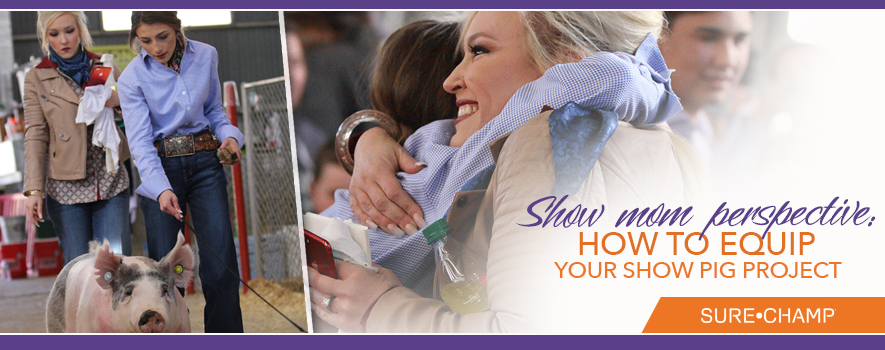
Showing livestock becomes more competitive each year. And parents, beware. The necessary equipment and supplies probably seem a little different than when you showed. For excited pig showmen, the list might seem daunting for such a small animal, but we talked to seasoned stock show mom, Riley Ann Price, Snyder, Texas, and she broke her list into four basic categories. She and her husband Tyson farm cotton over a four-county area in Texas, and with daughters Tyleigh and Tatum-Bec 10-years-apart in age, they realized they’d be showing pigs for a long while. They decided early on “if it’s worth doing, it’s worth doing right the first time.”
Price, who showed pigs herself as a young competitor, said when Tyleigh first started showing, she realized there had been some significant changes to the way things were done since she was a new showman. Although, the list of supplies can be overwhelming, she has one reminder for all parents.
“A show mom can have every supply on the market and every piece of equipment that money can buy, but the most important thing she can carry into that show barn is confidence for her child,” Price said. “It’s about what you’re instilling in your child and the value that brings to your family. If I could, I would tell every show mom in the world that it’s not about the pig you bought your child, the equipment, or the trailer you pull up in; but it’s about what’s inside your heart and what you teach your child.”
Feeding
Feeding and watering your pigs is crucial to your project’s success. A constant supply of fresh, clean water is important, and having a watering system that provides that is critical.
“Automatic waterers are a great addition to any pig barn as having an unlimited water supply is crucial. They have to have constant water,” Price said. “However, there are many other options if this type of system is not feasible.”
Sullivan’s Supply sells a waterer that holds two-gallons at a time, that hangs on the gate and can be adjusted by height. You could also take these to the show with you. Just be sure you have someone to check and fill the waterer a couple times each day.
She also suggests an 18-inch feed pan to hang on the fence for the pig, which is big enough to stay with the pig during its lifetime as a show animal. Since pigs are animals of routine, make sure this is the pan that grows with them, since the less you change, the less likely they are to go off feed.
Be sure you have a method to measure your feed for each feeding, which should take place twice daily, and 12 hours a part. This can be as simple as a coffee can or measuring cup from your kitchen, a feed scoop or the cup that most feed suppliers provide.
Finally, when it comes to feeding, make sure you are tracking your progress. You will need access to a scale, a notebook, and/or a dry-erase board. Most people pick one day a week to weigh their pigs and weigh the same time each week, ie: Sunday night after feeding. They track the weekly weights in a permanent notebook. They might also post their feed rations and any vaccinations given to the pigs in the notebook with the date. On the dry-erase board, they might write the current rations, so they can easily see what each pig gets at each feeding, and easily make changes, based on the weight and appearance of the pig for that given time period.
Around Home
Two things that Price emphasized are very important for the pigs you bring home are fine, white pine bedding and a place for exercise. Every pig pen should be bedded with fine, white pine shavings that are cleaned regularly and kept dry. Her family prefers a Canadian brand called Champion Shavings that are soft so the pigs don’t get scratched, and they are easy to clean. Under the feeder and waterer, Price likes to use an pelleted horse bedding that expands when it gets wet to try to contain any runoff in those areas and keep the rest of the pen dry.
Exercise is very important to your pig’s success. You will want a place outside of the pen to walk your pig. This should be a safe place for both the kid and pig – void of holes, wire, boards or anything else that might trip or poke the pig or showman.
As soon as you unload your first show pig projects in your barn, you will want two other essential items, a whip and a rice root brush. The whip should be used each time you get the pig out of its pen to get the pig accustomed to the commands of the whip, and so the young exhibitor gets used to the whip. Be sure to have a whip that is the appropriate length for your showman. Price prefers a black whip over any bright or neon colored whips.
“You want your pig to be the center of attention, and when you’ve got that neon green whip walking around out there, it is just distracting. The other thing is if you have a showman who is still developing their skill, when they’ve got a neon colored whip, they stick out like a sore thumb, because every mistake they make is just 10 times more obvious because it’s in neon. That is just my opinion,” she said.
Price said that every kid that shows a pig needs a rice root brush. The bristles on the rice-root brush help clean out pores and release natural oils in pig’s skins to help the hair lay right while keeping the dirt and grime off. Brushing the pig helps keep them clean and shiny, with their own oils, especially white hogs. Price cautions these brushes should be left at home, as they can cause scratches and redness on your pigs that will stay on the pigs if accidentally used at the show.
Grooming
Besides feeding and exercising, grooming can change the appearance of your animal as fast as anything. For grooming, you will need soap, a hose, a scrubber, a soft brush, clippers, rags, spray bottles and conditioner.
A variety of shampoos for both humans and livestock are used on show pigs. The Price family prefers to use Mane N Tail on their pigs that they wash regularly. To moisturize their pigs’ skin, they prefer Champion’s Choice available from Sullivan’s Supply. They brush it in every night.
Price recommends a set of cordless clippers with assorted clipper guards to get your pig clipped for the show. You will also need spray bottles for water at the show, rags and a soft brush. Price recommends a soft, horse-hair brush with a handle, that won’t leave scratches or marks on the pig for show days. She also is a big fan of the white T-shirt type painters’ rags that come in bulk. She prefers those rags because they are smaller, light weight, and don’t leave behind colored or white fuzz on pigs.
At the Show
When going to a show, Price stresses the importance of taking a divider panel, since most exhibitors will share a pen with somebody.
“You have to have a divider panel in your trailer. You worked too hard to have your pig injured, so take your panel with you,” she said.
She also prefers the aluminum show box that hangs on the fence, filled with the brushes, rags, soap, conditioner, spray bottles for water, wire and wire cutters. Her show box isn’t complete without a zipper type pencil case she has with extra supplies like safety pins, bobby pins, ink pens, and extra-long commercial grade zip ties.
“This is something I tell stock show moms all the time that are new to our group or who’s kids are new to showing. Everybody in this barn is the same, We’re all here for our kids. We all want to win; we all want to do good; we all want to be successful; we all love our animals. At the end of the day, we’re a pretty close-knit group of folks. If I see you struggling with something and I see you don’t have something, I’ll be the first to hand it to you. I feel like there are other people like that in the barn. People want to help each other,” Price said.

For a complete list of recommended products with buy now links:
Sure Champ Checklist of Pig Equipment


